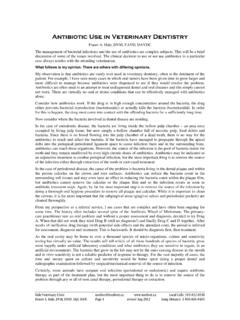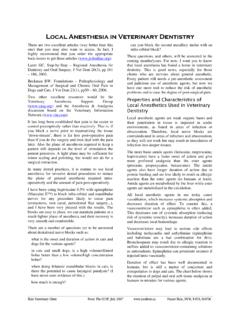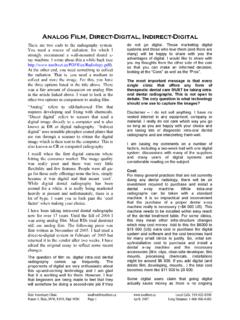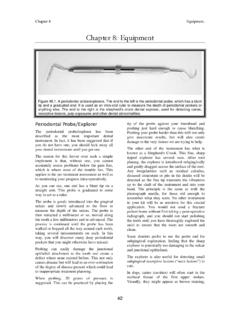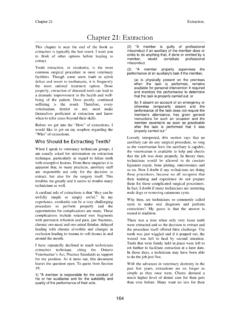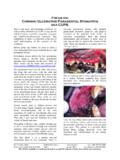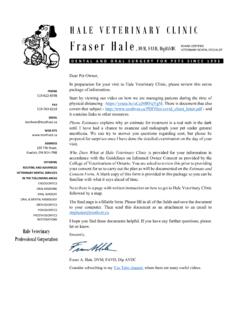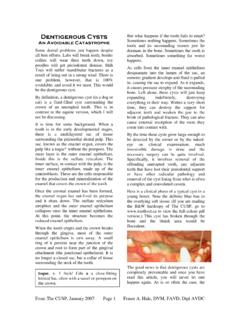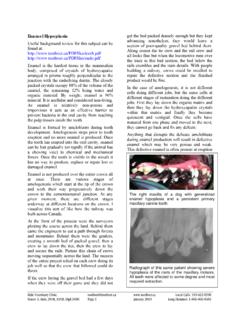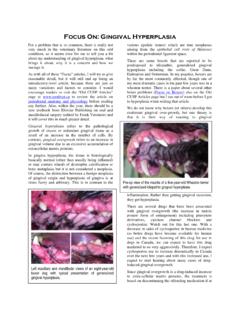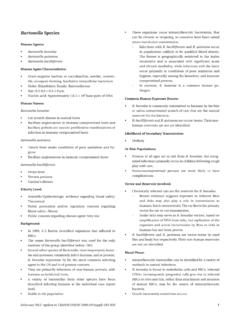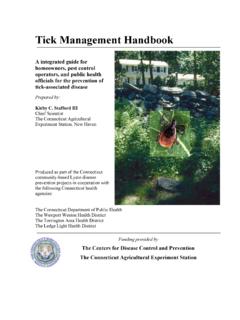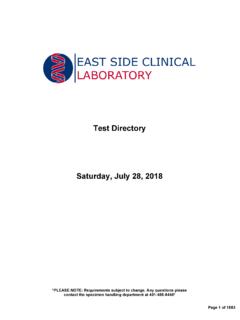Transcription of The Disease Formerly Known as …
1 Hale Veterinary Clinic Local Calls: 519-822-8598 Fraser A. Hale, DVM, FAVD, Dipl AVDC Page 1 December 2010 Long Distance: 1-866-866-8483 What follows is going to contain generalizations and guidelines that may or may not apply to any specific case. It is not possible to cover all situations and scenarios in a newsletter and there will be some simplification of complex issues. Do not consider this the last word . As the attending veterinarian, it will be your job to gather credible information and make the clinical judgment about how it applies to your patient(s). Also keep in mind that what we know is constantly evolving. The following is based on my understanding of the situation at time of writing. The Disease Formerly Known as Lymphocytic/Plasmacytic Gingivo-stomatitis I have been seeing a lot of enquiries about cats with refractory chronic oral inflammatory Disease following extraction of all premolars and molars.
2 It made me wonder where people were getting the idea that this condition can reasonably be treated by just removing the back teeth and then it was pointed out that one of my own old papers on this subject, available on my website, actually suggests caudal extraction as a reasonable option in some cases. So, time for an update on this most frustrating and painful of feline oral diseases. The first thing I would like to address is nomenclature. The condition (or spectrum of conditions) I am referring to has been referred to as lymphocytic/plasmacytic gingivitis (LPS) or gingivostomatitis (LPGS), just feline stomatitis and a number of similar labels. Old habits die hard, but we are encouraged to abandon these terms in favour of more useful and accurate nomenclature.
3 The Nomenclature Committee of the American Veterinary Dental College has been hard at work and has a web-page that covers this and much more. Go have a look - #OP. That said, I still find it useful to have a quick label to use as a broad category, not a specific diagnosis. I have been in the habit of calling this Chronic Oral Inflammatory Disease or COID but a more widely accepted nickname for this condition is Feline Chronic Gingivostomatitis or FCGS, which is the acronym I will use for the rest of this article. Be Specific When describing oropharyngeal inflammation, it is important to be geographically specific. You want to record specifically where the inflammation is occurring. What follows is copied directly from the AVDC Nomenclature page. Gingivitis: inflammation of gingiva Periodontitis: inflammation of non-gingival periodontal tissues ( , the periodontal ligament and alveolar bone) Alveolar mucositis: inflammation of alveolar mucosa ( , mucosa overlying the alveolar process and extending from the mucogingival junction without obvious demarcation to the vestibular sulcus and to the floor of the mouth) Sublingual mucositis: inflammation of mucosa on the floor of the mouth Labial/buccal mucositis: inflammation of lip/cheek mucosa Caudal mucositis: inflammation of mucosa of the caudal oral cavity, bordered medially by the palatoglossal folds and fauces, dorsally by the hard and soft palate, and rostrally by alveolar and buccal mucosa Contact mucositis and contact mucosal ulceration.
4 Lesions in susceptible individuals that are secondary to mucosal contact with a tooth surface bearing the responsible irritant, allergen, or antigen. They have also been called contact ulcers and kissing ulcers . Palatitis: inflammation of mucosa covering the hard and/or soft palate Glossitis: inflammation of mucosa of the dorsal and/or ventral tongue surface Cheilitis: inflammation of the lip (including the mucocutaneous junction area and skin of the lip) Osteomyelitis: inflammation of the bone and bone marrow Stomatitis: inflammation of the mucous lining of any of the structures in the mouth; in clinical use the term should be reserved to describe wide-spread oral inflammation (beyond gingivitis and periodontitis) that may also extend into submucosal tissues ( , marked caudal mucositis extending into submucosal tissues may be termed caudal stomatitis) Hale Veterinary Clinic Local Calls: 519-822-8598 Fraser A.
5 Hale, DVM, FAVD, Dipl AVDC Page 2 December 2010 Long Distance: 1-866-866-8483 Tonsillitis: inflammation of the palatine tonsil Pharyngitis:inflammation of the pharynx Photographic examples of each of these are also on the AVDC web page. Go have a look. It is very important to not only be specific in the written records but also to maintain photographic or pictorial records of the distribution and severity of inflammation so that response to therapy and the passage of time can be accurately assessed. Etiology The short answer here is that we do not know the cause(s) of this condition. If anyone claims to know the cause, ask to see some real evidence to back their claim. At time of writing, there is none. Back in 2000, Frank Verstraete of UCDavis presented a paper at the Veterinary Dental Forum. After an extensive literature search he concluded that the only statement he could make was that the condition is an atypical immune response of unknown etiology.
6 Since that time, various theories have been proposed but none have held up to scrutiny. A draft position statement from the European Veterinary Dental College states that the condition can be thought of as an individual inappropriate immunologic response from the cat to a variety of antigenic triggers rather than in terms of specific causal agents. The statement then cautions against focusing on the immunologic response as this often leads to inappropriate use of immunosuppressive agents. Rather it is felt that in order to achieve good control of the syndrome, it is essential to identify these antigenic trigger factors so that it can be appropriately managed. There have been some statistical associations with various infectious agents reported but that means nothing with respect to cause-and-effect.
7 Every cat I see with this condition has two ears so there is a very strong statistical association there, but it is totally irrelevant. Also, many of the supposed statistical associations have since been debunked as unrepeatable or simply not there when larger numbers and better inclusion criteria were used. Bacteria Every cat mouth is full of hundreds of species of bacteria (as is your own) and teasing out which are causing problems and which are present without harm is very difficult. While there is no evidence that any particular bacteria is the cause it is felt that bacterial plaque (the same dirty slime that causes garden-variety gingivitis and periodontitis) plays a significant role and so must be managed scrupulously. Bartonella Some years ago, a rumour was started that FCGS was, at least in some cases, associated with/caused by Bartonella.
8 As we are all desperate to find the cause and the cure , this news spread wide and far and now it is a common misconception in the profession and elsewhere. In the years since this idea first found the light of day, there has been no credible evidence that there is any connection between Bartonella and FCGS. Therefore, testing for Bartonella is only indicated if you live in an endemic area and/or if your patient or any members of their family are showing clinical signs of Bartonella or cat scratch fever . If your patient has concurrent Bartonella infection, treatment may be indicated. Since treatment is azythromycin (an antibiotic), and cats with FCGS often do show temporary improvement with antibiotics, their oral Disease may improve while on treatment. However, as soon as drugs are finished the problem comes roaring back.
9 Getting the patient Bartonella-free has no lasting effect on oral health. There is no credible justification for testing for or treating empirically for Bartonella simply because the patient has FCGS. Viruses Current thinking is that FeLV and FIV may exacerbate symptoms of FCGS but are not causative agents. One question is, is it the virus itself or the immunosuppression that it causes that results in the anecdotal observation that FIV and FeLV positive cats are more severely affected? There does seem to be evidence that calicivirus is a player in FCGS but more as a modifying agent than as a causative one. I see this as academic, since a cat that has calicivirus always will have it. You cannot do anything about this. Knowing that the cat is calicivirus positive does not really change the treatment plan.
10 Herpes virus has been suggested as a player in FCGS but there is no evidence that carriers or shedders are more common in the FCGS population than in the general cat population. Also, anti-herpetic therapies such as nucleoside analogs and lysine seem to have no beneficial effect in the management of FCGS. Food Antigens While food antigen may or may not play a role, most feel it is more important to feed the cat what it is Hale Veterinary Clinic Local Calls: 519-822-8598 Fraser A. Hale, DVM, FAVD, Dipl AVDC Page 3 December 2010 Long Distance: 1-866-866-8483 willing to eat than to institute a hypoallergenic feeding trial. Maintaining an adequate plane of nutrition is essential and often these cats are dysphagic to some degree. Diagnosis With respect to periodontal health, each tooth in each patient (dog or cat) will lie somewhere on the spectrum from perfectly healthy gingiva and periodontal tissues to end-stage periodontal Disease (which can include various combinations of gingivitis, gingival recession, alveolar bone loss and pocket formation).
